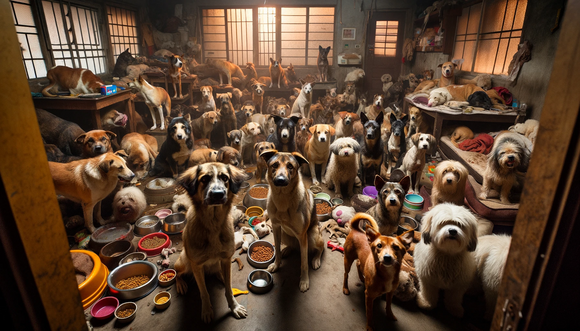When love for dogs gets out of control: Animal Hoarding explained

What is animal hoarding?
Animal Hoarding, also known as "Animal Messie Syndrome", is a psychological problem in which people accumulate an uncontrolled number of animals. These individuals are often unable to provide adequate care for the animals, resulting in poor living conditions and health problems for the animals.
Definition and characteristics
Animal Hoarding is characterized by the following features:
- Excessive number of animals: Many more animals are kept than can be reasonably cared for.
- Inadequate care: Animals often suffer from malnutrition, disease and injury due to lack of care.
- Denial of reality: Hoarders often do not realize that they are harming their animals and refuse to help.
Causes and triggers
Animal hoarding can be triggered by various psychological and emotional factors. Traumatic experiences and mental health problems often play a role.
Psychological backgrounds
- Obsessive-compulsive disorders: Many hoarders suffer from obsessive-compulsive disorder, which leads them to take in more and more animals.
- Loneliness and isolation: Some people try to alleviate their loneliness through the company of animals.
- Loss and trauma: The loss of a loved one or traumatic experiences can lead someone to accumulate animals as an emotional substitute.
Effects on the dogs
The consequences of animal hoarding are often devastating for the affected dogs. The animals live in extremely poor conditions and do not receive the care and attention they need.
Health problems
- Malnutrition: Many hoarders are unable to provide enough food, leading to malnutrition.
- Diseases and parasites: Overcrowded and unsanitary conditions favor the spread of diseases and parasites.
- Injuries: Due to fights or inadequate care, many dogs suffer injuries.
Emotional and behavioral problems
- Anxiety and stress: The overcrowded and often chaotic living conditions cause high levels of stress and anxiety in dogs.
- Socialization problems: Many dogs from these situations have problems adjusting to normal social environments and contact with people.
Recognition and help
If you suspect someone is an animal hoarder, there are signs you should look out for and steps you can take to help.
Signs of animal hoarding
- Overcrowded spaces: A home populated by a large number of animals living in a confined space.
- Neglected animals: Animals that are obviously malnourished, sick or injured.
- Unsanitary conditions: Strong odor, animal feces and urine in the home.
Help and support
- Animal shelters and animal welfare organizations: Contact local animal welfare organizations or shelters that can help rescue and care for the animals.
- Involve the authorities: In serious cases, the local authorities should be involved to take legal action and rescue the animals.
- Psychological support: People suffering from animal hoarding often need professional psychological help to overcome their problems.
Animal hoarding is a serious problem that has serious consequences for both the animals affected and the people themselves. By raising awareness of this issue and being prepared to intervene and help, we can improve the lives of many dogs. Your love for dogs should always be accompanied by common sense and a sense of responsibility - only then can we ensure that our four-legged friends have the best possible lives.